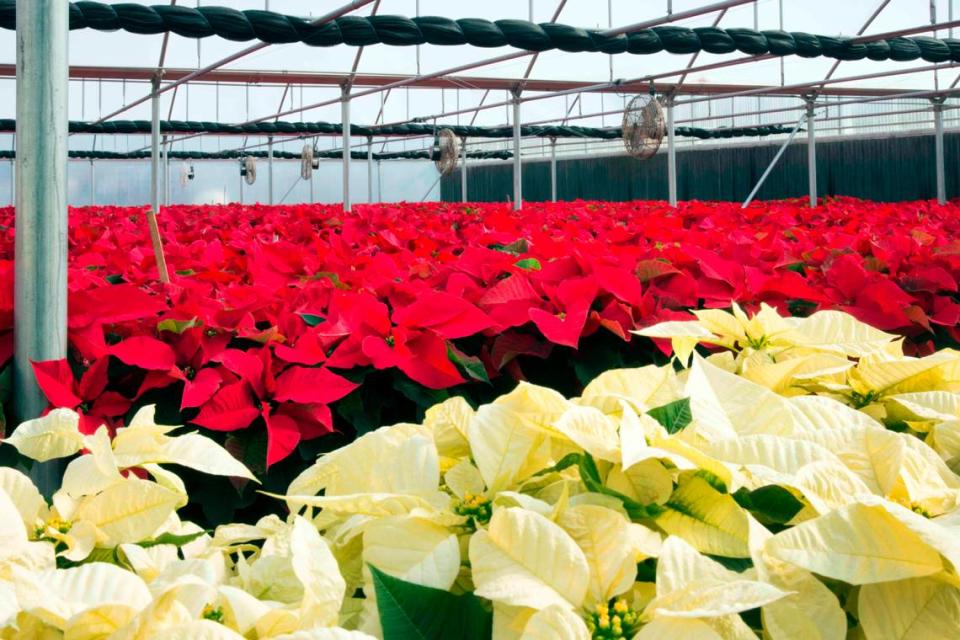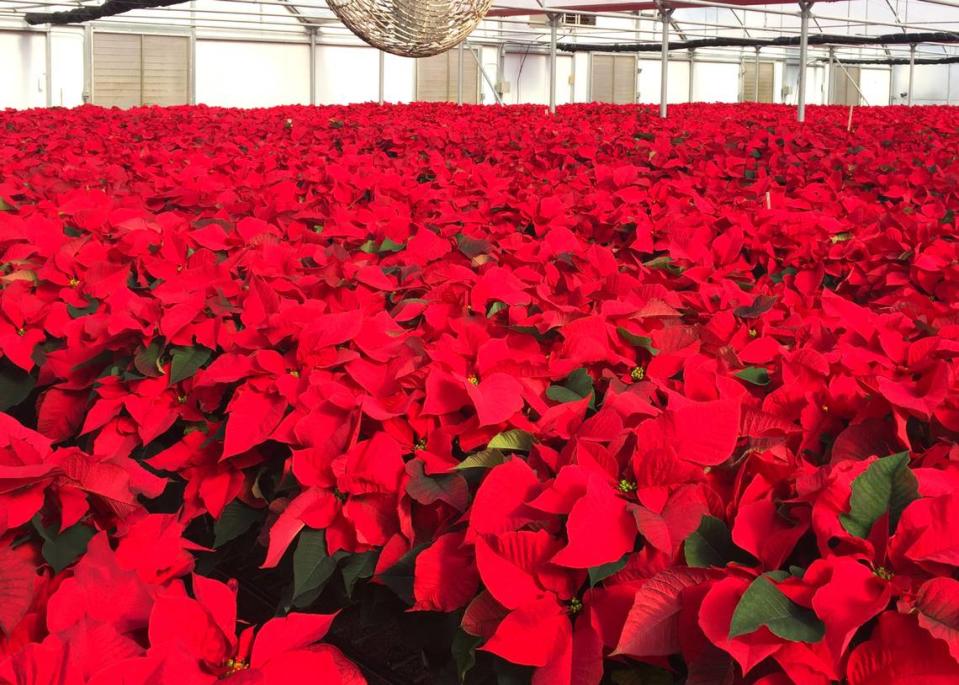Are poinsettias poisonous? Plus other things you might not know about the Christmas plant
- Oops!Something went wrong.Please try again later.
Greenhouse growers love their poinsettias. As major holiday crops go, they’re certainly a lot easier than lilies or hydrangeas, and a good grower can bring them along in a rather predictable process.
When I was a kid, I pictured myself as being a successful greenhouse grower, and poinsettias were going to be one of my mainstays. My college degrees were aiming me that way, but a career in Extension horticulture and then into horticultural journalism stepped in the way. That’s the way life goes — you look for your niche and you try to fill it.
And so it is that for 50 years I’ve told you about the developments in poinsettias instead of creating them. Let’s revisit some of the highlights.
It began when longtime statesman and South Carolina politician Joel Roberts Poinsett was appointed as the first Minister to Mexico by the James Monroe administration. He served from 1825-1830 but became embroiled in political issues and was recalled to the U.S.
However, being an amateur botanist, he had noticed a plant growing in gardens south of Mexico City, a plant called locally Flor de Nochebuena — the flower of Christmas Eve. He brought it back to the United States, and soon it became popular, known by his name as “Poinsettia.” (Note the “i” in the final syllable, and yes, it is said as the name is called out loud.)

Take a giant step forward by several decades and Paul Ecke, the son of a hard-working dairy and orchard farmer in Southern California, realized that people had roses for Valentine’s Day and lilies for Easter, but there was no special flower for Christmas. Yet here was a flower that bloomed in gardens around them at that time of the year.
Ecke began to buy land and raise poinsettias as cut flowers. More and more acres each year. As the word spread, people outside Southern California were craving their own poinsettias, which meant growing them in pots so they would last longer. By then another generation of Eckes had come into the business, and greenhouse crops of potted poinsettias came into being.
But those initial crops were far too tall. And they lost lower leaves. They often were gangly and unattractive, requiring extra ferns or other foliage be added in. I even saw poinsettia stems folded and clipped to reduce the plant’s total height.
About the time I got into the business in the 1960s and early 70s, self-pinching (branching) varieties were coming into the market. Many were Ecke selections, but other breeders, some from Europe, were also becoming important in the industry. Those plants stayed shorter and more compact. Growth retardants were being used to limit the plants’ total height, and growers were figuring out how to bring their plants along week by week to a perfect finished product ready to deliver to their customers a week or two before Thanksgiving and from then until their final deliveries to churches as late as Christmas Eve.
Even now, new varieties of poinsettias enter the market each year. Some have new shades of red, pink or white. Some are interesting bicolors. Some have deeper green foliage. Some have good staying power. Others get tried one year and growers give thumbs-down thereafter for whatever their reasons.

Some things I know we’ve covered before here, but that need to be mentioned every time poinsettias are the topic:
▪ Poinsettias are not poisonous. That white latex sap may cause skin or eye irritation, but it’s not going to kill you, your kids, or your pets, so you can put that old myth out in the compost. That research was done in 1974 at Ohio State.
▪ Poinsettias are in the Euphorbia plant family, along with crown-of-thorns, baseball cactus, pencil plant and a huge bunch of other succulent plants. Most of them also have the white latex sap, yet they’re not harmful either.
▪ Poinsettias you’re enjoying right now were nothing more than unrooted cuttings back in early August. That’s now quickly they come along.
▪ Yet if you keep this year’s poinsettia and grow it on beyond Christmas, you’ll have to give it lots of room. Repot it into a five gallon pot, then later into a 10vgallon pot. You could actually grow it in the ground if you lived in an area where temperatures never dropped near freezing. It would grow to be 12 feet tall and wide, and its flowers would be 20% the size of the ones you have now. Beautiful, but small.
▪ All poinsettia flowers are yellow. They’re the tiny taco-shaped structures filled with sticky sweet goo. You’ll find them tucked into the centers of each of the floral bracts. What you may have been calling “petals” are actually modified leaves.
▪ So now you know more about this mystical flower of the season. Keep yours moist (not wet — just don’t let it wilt). Put it in a bright spot away from heat registers and prepare to enjoy it for many weeks, even months.
Thanks to my friend Kenneth Cranfill of Forest Grove Nursey, recently retired, for allowing me to photograph some of his last crops of beautiful poinsettias. He’s now doing volunteer work six days a week. One of the best growers ever in Texas.

